Assessment of Solar Radiation Datasets for Building Energy Simulation
Abstract
1. Introduction
2. Materials and Methods
2.1. Baseline Climate Scenario Based on Observed Data
2.1.1. Area of Study
2.1.2. Sources of Ground-Based Climate Observations
2.1.3. Climatic Characterization of the Area of Study
2.1.4. Construction of Baseline Actual Weather Years (AMYs)
2.2. Alternative Climate Scenarios Based on Modeled Solar Radiation
2.2.1. Modeled Solar Radiation Datasets
- NASA POWER (Prediction of Worldwide Energy Resources) [24]The NASA Prediction of Worldwide Energy Resources (POWER) dataset provides hourly estimates of the GHI, DNI, and DHI, derived from satellite imagery, reanalysis models, and ground-based observations. It offers global coverage at approximately 0.5° spatial resolution and spans from 1983 to the present [52].Hourly irradiance values were retrieved from the POWER Data Access Viewer (DAV), based on the CERES SYN1deg Edition 4.1 satellite product. These data undergo a bias-correction procedure developed by NASA, which is applied across bins of the cosine of the solar zenith angle (cos Z). This adjustment reduces the systematic errors in the GHI and DHI relative to measurements from the Baseline Surface Radiation Network (BSRN). The Direct Normal Irradiance is then computed from the corrected direct horizontal irradiance (DirHI) using the relation DNI = DirHI/cos(Z), with specific handling of high zenith angles to mitigate numerical instability [24].The final data were downloaded in comma-separated values (CSV) format and subsequently synchronized both temporally and spatially with the other datasets used in this study, ensuring consistency for comparative assessments and building energy simulations.
- CAMS Radiation Service (Copernicus Atmosphere Monitoring Service)The CAMS Radiation Service provides solar radiation estimates based on satellite imagery, radiative transfer models, and atmospheric composition data. It offers high spatial (5–15 km) and temporal resolution (up to one minute) and has been validated across multiple climatic regions. The data are freely available through the Copernicus Climate Data Store [9,53] (https://ads.atmosphere.copernicus.eu (accessed on 9 March 2025)). In Brazil, validation of the CAMS solar radiation data is primarily conducted using measurements from the Florianopolis station, which is part of the Baseline Surface Radiation Network (BSRN). This station provides high-quality data on global, diffuse, and direct solar radiation at 1 min intervals. The data are accessed through the BSRN’s central archive, which ensures standard formatting for automated processing. The validation process involves comparing these ground-based measurements with the outputs of the CAMS Radiation Service to assess the accuracy and reliability [9].
- Produced by the European Centre for Medium-Range Weather Forecasts (ECMWF), the ERA5 reanalysis dataset integrates historical observations with atmospheric modeling. It offers hourly solar radiation and meteorological data at ~0.25° spatial resolution from 1959 onward. ERA5 data are freely available through the Copernicus Climate Data Store (CDS) (https://cds.climate.copernicus.eu/ (accessed on 3 July 2025)), where users can customize downloads by selecting variables (e.g., surface solar radiation downwards), geographical region, and time range.Due to its temporal resolution (up to one hour), global coverage, and consistency, the ERA5 is widely used in climate research, energy modeling, and environmental assessments. In this study, ERA5 data were downloaded in NetCDF format and post-processed using custom MATLAB R2025a scripts to ensure spatial and temporal alignment with the other datasets under evaluation.
2.2.2. Construction of Alternative Actual Weather Years (AMYs)
2.2.3. Performance Metrics for Solar Dataset Evaluation
2.3. Building Performance Simulation
2.3.1. Building Prototype and Simulation Outputs
- Bedrooms (regularly occupied spaces): two occupants per bedroom (100% occupancy), mainly during nighttime (22:00–07:00).
- Living room (regularly occupied space): number of occupants equivalent to two per bedroom, with a maximum of four occupants, typically during the evening (18:00–22:00).
- Other transiently occupied spaces: short-term use, with negligible impact on thermal load modeling.
2.3.2. Evaluation of Simulation Results Under Climatic Variability and Solar Dataset Effects
3. Results
3.1. Performance Metrics of Solar Radiation Datasets
3.1.1. Global Horizontal Irradiance (GHI)
3.1.2. Direct Normal Irradiance (DNI)
3.1.3. Summary of GHI and DNI Dataset Performance
3.2. Impact on Building Energy Simulations
3.2.1. Simulation Results with Baseline Climate Scenario
3.2.2. Simulation Results with Modeled Solar Datasets
4. Conclusions
- NASA POWER showed the closest alignment with observed data, particularly in 2015, for both the GHI and DNI. It achieved a high correlation, low RMSE, and regression slopes close to unity, accurately capturing both the magnitude and seasonal behavior of solar irradiance.
- CAMS delivered consistent results across both years, with strong correlation and low RMSE for the GHI and a systematic underestimation of the DNI (~–26%). This predictable bias, coupled with temporal stability, makes CAMS a practical dataset for calibrated simulations, supporting both energy demand estimation and thermal comfort assessments.
- ERA5, while adequate for GHI in 2015, showed a considerable decline in accuracy in 2024, particularly for the DNI, where the correlation dropped to 0.21, and the RMSE exceeded 330 W/m2. This dataset exhibited a pronounced phase shift relative to measured data, resulting in negligible correlation and potentially severely compromising the building energy simulation outcomes.
- NASA POWER not only reproduced the correct irradiance magnitudes but also captured the seasonal dynamics, resulting in simulations that closely matched the observed building behavior.
- CAMS, despite underestimating the DNI, produced balanced thermal performance predictions. Its seasonal alignment with the observed data supported reasonable heating and cooling estimates and a thermal comfort profile that closely mirrored real-world expectations.
- ERA5’s overestimation of solar gains in 2024 led to exaggerated cooling demand and increased overheating discomfort, especially during warmer months. This could result in the oversizing of cooling systems and misalignment with actual occupant needs.
Author Contributions
Funding
Data Availability Statement
Conflicts of Interest
References
- Tuluxun, N.; Halike, S.; Liu, H.; Yelaixi, B.; Ailaitijiang, K. Climate Adaptation of Folk House Envelopes in Xinjiang Arid Region: Evaluation and Multi-Objective Optimization from Historical to Future Climates. Buildings 2025, 15, 1240. [Google Scholar] [CrossRef]
- Kutty, N.A.; Barakat, D.; Darsaleh, A.O.; Kim, Y.K. A Systematic Review of Climate Change Implications on Building Energy Consumption: Impacts and Adaptation Measures in Hot Urban Desert Climates. Buildings 2024, 14, 13. [Google Scholar] [CrossRef]
- Shen, P.; Li, Y.; Gao, X.; Chen, S.; Cui, X.; Zhang, Y.; Zheng, X.; Tang, H.; Wang, M. Climate Adaptability of Building Passive Strategies to Changing Future Urban Climate: A Review. Nexus 2025, 2, 100061. [Google Scholar] [CrossRef]
- Parker, D.S.; Panchabikesan, K.; Crawley, D.B.; Lawrie, L.K. Impact of Newer Climate Data for Technical Analysis of Residential Building Energy Use in the United States. Energy Build. 2024, 323, 114828. [Google Scholar] [CrossRef]
- Gürel, A.E.; Ağbulut, Ü.; Bakır, H.; Ergün, A.; Yıldız, G. A State of Art Review on Estimation of Solar Radiation with Various Models. Heliyon 2023, 9, e13167. [Google Scholar] [CrossRef] [PubMed]
- NASA. NASA POWER Homepage. Available online: https://power.larc.nasa.gov/ (accessed on 9 July 2025).
- Hersbach, H.; Bell, B.; Berrisford, P.; Biavati, G.; Horányi, A.; Muñoz Sabater, J.; Nicolas, J.; Peubey, C.; Radu, R.; Rozum, I.; et al. ERA5 Hourly Data on Single Levels from 1940 to Present; Copernicus Climate Change Service (C3S) Climate Data Store (CDS): Brussels, Belgium, 2023. [Google Scholar] [CrossRef]
- Hersbach, H.; Bell, B.; Berrisford, P.; Hirahara, S.; Horányi, A.; Muñoz-Sabater, J.; Nicolas, J.; Peubey, C.; Radu, R.; Schepers, D.; et al. The ERA5 Global Reanalysis. Q. J. R. Meteorol. Soc. 2020, 146, 1999–2049. [Google Scholar] [CrossRef]
- Copernicus Atmosphere Monitoring Service. CAMS Solar Radiation Time-Series; Copernicus Atmosphere Monitoring Service (CAMS) Atmosphere Data Store: Brussels, Belgium, 2020. [Google Scholar] [CrossRef]
- Yang, D.; Bright, J.M. Worldwide Validation of 8 Satellite-Derived and Reanalysis Solar Radiation Products: A Preliminary Evaluation and Overall Metrics for Hourly Data over 27 Years. Sol. Energy 2020, 210, 3–19. [Google Scholar] [CrossRef]
- Yang, D. SolarData: An R Package for Easy Access of Publicly Available Solar Datasets. Sol. Energy 2018, 171, A3–A12. [Google Scholar] [CrossRef]
- Jensen, A.R.; Anderson, K.S.; Holmgren, W.F.; Mikofski, M.A.; Hansen, C.W.; Boeman, L.J.; Loonen, R. Pvlib Iotools—Open-Source Python Functions for Seamless Access to Solar Irradiance Data. Sol. Energy 2023, 266, 112092. [Google Scholar] [CrossRef]
- Pfenninger, S.; Staffell, I. Long-Term Patterns of European PV Output Using 30 Years of Validated Hourly Reanalysis and Satellite Data. Energy 2016, 114, 1251–1265. [Google Scholar] [CrossRef]
- Aliana, A.; Chang, M.; Østergaard, P.A.; Victoria, M.; Andersen, A.N. Performance Assessment of Using Various Solar Radiation Data in Modelling Large-Scale Solar Thermal Systems Integrated in District Heating Networks. Renew. Energy 2022, 190, 699–712. [Google Scholar] [CrossRef]
- Borujeni, M.S.; Ofetotse, E.L.; Nebel, J.C. A Solar Backup System to Provide Reliable Energy in Presence of Unplanned Power Outages. J. Energy Storage 2022, 47, 103653. [Google Scholar] [CrossRef]
- Khan, M.U.; Jama, M.A. Evaluation and Correction of Solar Irradiance in Somaliland Using Ground Measurements and Global Reanalysis Products. Heliyon 2024, 10, e35256. [Google Scholar] [CrossRef]
- Herdies, B.R.; Vendrasco, E.P.; Herdies, D.L.; de Oliveira, C.E.L.; de Quadro, M.F.L. The Use of Atmospheric Reanalysis Data for the Estimation of Solar Irradiation Considering the Effect of Atmospheric Aerosols over Brazil. Atmosphere 2025, 16, 124. [Google Scholar] [CrossRef]
- Amorim, A.C.B.; de Almeida Dantas, V.; dos Reis, J.S.; de Assis Bose, N.; Emiliavaca, S.d.A.S.; Cruz Bezerra, L.A.; de Matos, M.dF.A.; de Mello Nobre, M.T.C.; Oliveira, L.d.L.; de Medeiros, A.M. Analysis of WRF-Solar in the Estimation of Global Horizontal Irradiation in Amapá, Northern Brazil. Renew. Energy 2024, 235, 121361. [Google Scholar] [CrossRef]
- Ndiaye, A.; Wane, D.; Dione, C.; Gaye, A.T. Assessing Solar Energy Production in Senegal under Future Climate Scenarios Using Regional Climate Models. Sol. Energy Adv. 2025, 5, 100101. [Google Scholar] [CrossRef]
- Bre, F.; e Silva Machado, R.M.; Lawrie, L.K.; Crawley, D.B.; Lamberts, R. Assessment of Solar Radiation Data Quality in Typical Meteorological Years and Its Influence on the Building Performance Simulation. Energy Build. 2021, 250, 111251. [Google Scholar] [CrossRef]
- Wu, Y.; An, J.; Gui, C.; Xiao, C.; Yan, D. A Global Typical Meteorological Year (TMY) Database on ERA5 Dataset. Build. Simul. 2023, 16, 1013–1026. [Google Scholar] [CrossRef]
- Driemel, A.; Augustine, J.; Behrens, K.; Colle, S.; Cox, C.; Cuevas-Agulló, E.; Denn, F.M.; Duprat, T.; Fukuda, M.; Grobe, H.; et al. Baseline Surface Radiation Network (BSRN): Structure and Data Description (1992–2017). Earth Syst. Sci. Data 2018, 10, 1491–1501. [Google Scholar] [CrossRef]
- Sengupta, M.; Xie, Y.; Lopez, A.; Habte, A.; Maclaurin, G.; Shelby, J. The National Solar Radiation Data Base (NSRDB). Renew. Sustain. Energy Rev. 2018, 89, 51–60. [Google Scholar] [CrossRef]
- Zhang, T.; Stackhouse, P.W.; Macpherson, B.; Colleen Mikovitz, J. A CERES-Based Dataset of Hourly DNI, DHI and Global Tilted Irradiance (GTI) on Equatorward Tilted Surfaces: Derivation and Comparison with the Ground-Based BSRN Data. Sol. Energy 2024, 274, 112538. [Google Scholar] [CrossRef]
- Copper, J.K.; Sproul, A.B. Comparative Building Simulation Study Utilising Measured and Estimated Solar Irradiance for Australian Locations. Renew. Energy 2013, 53, 86–93. [Google Scholar] [CrossRef]
- Salazar, G.; Gueymard, C.; Galdino, J.B.; de Castro Vilela, O.; Fraidenraich, N. Solar Irradiance Time Series Derived from High-Quality Measurements, Satellite-Based Models, and Reanalyses at a near-Equatorial Site in Brazil. Renew. Sustain. Energy Rev. 2020, 117, 109478. [Google Scholar] [CrossRef]
- Qin, Y.; McVicar, T.R.; Huang, J.; West, S.; Steven, A.D.L. On the Validity of Using Ground-Based Observations to Validate Geostationary-Satellite-Derived Direct and Diffuse Surface Solar Irradiance: Quantifying the Spatial Mismatch and Temporal Averaging Issues. Remote Sens. Environ. 2022, 280, 113179. [Google Scholar] [CrossRef]
- Lima, F.J.L.d.; Martins, F.R.; Costa, R.S.; Gonçalves, A.R.; dos Santos, A.P.P.; Pereira, E.B. The Seasonal Variability and Trends for the Surface Solar Irradiation in Northeastern Region of Brazil. Sustain. Energy Technol. Assess. 2019, 35, 335–346. [Google Scholar] [CrossRef]
- Sánchez-Hernández, G.; Jiménez-Garrote, A.; López-Cuesta, M.; Galván, I.M.; Aler, R.; Pozo-Vázquez, D. A Novel Method for Modeling Renewable Power Production Using ERA5: Spanish Solar PV Energy. Renew. Energy 2025, 240, 122120. [Google Scholar] [CrossRef]
- Araujo, M.A.d.S.G.; Aguilar, S.; Souza, R.C.; Cyrino Oliveira, F.L. Global Horizontal Irradiance in Brazil: A Comparative Study of Reanalysis Datasets with Ground-Based Data. Energies 2024, 17, 5063. [Google Scholar] [CrossRef]
- Crawley, D.B.; Lawrie, L.K. Climate.OneBuilding.Org. Available online: http://climate.onebuilding.org/papers/default.html (accessed on 1 July 2025).
- Tippett, A.; Gonçalves, A.R.; Pereira, E.B.; Martins, F.R.; Fisch, G.; Costa, R.S. Data Source Sensitivity in Solar Radiation Typical Meteorological Year (TMY) for Five Different Regions of Brazil. Tellus Ser. A Dyn. Meteorol. Oceanogr. 2024, 76, 29–41. [Google Scholar] [CrossRef]
- Da Cunha Bustamante, M.M. Climate Change and Children’s Health: Resilience Challenges for Brazil. J. Pediatr. 2025, 101, S3–S9. [Google Scholar] [CrossRef]
- Mantovani, J.R.; Alcântara, E.; Baião, C.F.; Pampuch, L.; Curtarelli, M.P.; Mariano Ribeiro, J.V.; Guimarães, Y.C.; Londe, L.; Massi, K.; Marengo, J.; et al. Unprecedented Flooding in Porto Alegre Metropolitan Region (Southern Brazil) in May 2024: Causes, Risks, and Impacts. J. S. Am. Earth Sci. 2025, 160, 105533. [Google Scholar] [CrossRef]
- Schaeffer, R.; Schipper, E.L.F.; Ospina, D.; Mirazo, P.; Alencar, A.; Anvari, M.; Artaxo, P.; Biresselioglu, M.E.; Blome, T.; Boeckmann, M.; et al. Ten New Insights in Climate Science 2024. One Earth 2025, 8, 101285. [Google Scholar] [CrossRef]
- Krüger, E.; Gobo, J.P.A.; Tejas, G.T.; da Silva de Souza, R.M.; Neto, J.B.F.; Pereira, G.; Mendes, D.; Di Napoli, C. The Impact of Urbanization on Heat Stress in Brazil: A Multi-City Study. Urban Clim. 2024, 53, 101827. [Google Scholar] [CrossRef]
- Terassi, P.M.d.B.; da Silva Oscar-Júnior, A.C.; Galvani, E.; de Oliveira-Júnior, J.F.; Sobral, B.S.; Biffi, V.H.R.; de Gois, G. Daily Rainfall Intensity and Temporal Trends in Eastern Paraná State—Brazil. Urban Clim. 2022, 42, 101090. [Google Scholar] [CrossRef]
- Pereira, E.B.; Martins, F.R.; Pereira, E.B.; Martins, F.R.; Gonçalves, A.R.; Costa, R.S.; Lima, F.J.L.d.; Rüther, R.; Abreu, S.L.d.; Tiepolo, G.M.; et al. Atlas Brasileiro de Energia Solar. INPE 2017, 2, 80. [Google Scholar]
- Solargis Global Solar Atlas. Available online: https://globalsolaratlas.info/map (accessed on 6 July 2025).
- INPE Sistema de Organização Nacional de Dados Ambientais. Available online: https://sonda.ccst.inpe.br/ (accessed on 1 July 2025).
- Dias da Silva, P.E.; Pereira, E.; Martins, F.; Pereira, S. Quality Control of Solar Radiation Data within Sonda Network in Brazil: Preliminary Results. In EuroSun; International Solar Energy Society (ISES): Freiburg, Germany, 2015; pp. 1–9. [Google Scholar]
- UFTPR Rede de Estações de Pesquisa Em Energia Solar-EPESOL Da UFTPR. Available online: https://utfpr.curitiba.br/labens/sobre/rede-de-estacoes-de-pesquisa-em-energia-solar/ (accessed on 1 July 2025).
- INMET Dados históricos anuais. Available online: https://portal.inmet.gov.br/dadoshistoricos (accessed on 1 July 2025).
- Veloso, A.C.O.; Souza, R.V.G. Climate Change Impact on Energy Savings in Mixed-Mode Ventilation Office Buildings in Brazil. Energy Build. 2024, 318, 114418. [Google Scholar] [CrossRef]
- Viezzer, J.; Schmidt, M.A.R.; dos Reis, A.R.N.; Freiman, F.P.; de Moraes, E.N.; Biondi, D. Restoration of Urban Forests to Reduce Flood Susceptibility: A Starting Point. Int. J. Disaster Risk Reduct. 2022, 74, 102944. [Google Scholar] [CrossRef]
- Betti, G.; Tartarini, F.; Nguyen, C.; Schiavon, S. CBE Clima Tool: A Free and Open-Source Web Application for Climate Analysis Tailored to Sustainable Building Design. Build. Simul. 2024, 17, 493–508. [Google Scholar] [CrossRef]
- Instituto Nacional de Meteorologia (INMET). Normais Climatológicas Do Brasil (1991–2020); INMET: Brasília, Brasil, 2022. [Google Scholar]
- Siu, C.Y.; Liao, Z. Is Building Energy Simulation Based on TMY Representative: A Comparative Simulation Study on Doe Reference Buildings in Toronto with Typical Year and Historical Year Type Weather Files. Energy Build. 2020, 211, 109760. [Google Scholar] [CrossRef]
- Bianchi, C.; Smith, A.D. Localized Actual Meteorological Year File Creator (LAF): A Tool for Using Locally Observed Weather Data in Building Energy Simulations. SoftwareX 2019, 10, 100299. [Google Scholar] [CrossRef]
- Hong, T.; Chang, W.; Lin, H. A Fresh Look at Weather Impact on Peak Electricity Demand and Energy Use of Buildings Using 30-Year Actual Weather Data. Appl. Energy 2013, 111, 333–350. [Google Scholar] [CrossRef]
- SIMEPAR Meteorological System of Paraná (SIMEPAR). Available online: https://www.simepar.br/ (accessed on 4 July 2025).
- NASA. NASA POWER DAV. Available online: https://power.larc.nasa.gov/data-access-viewer/ (accessed on 30 June 2025).
- Copernicus CAMS Solar Radiation Time-Series. Available online: https://ads.atmosphere.copernicus.eu/datasets/cams-solar-radiation-timeseries?tab=overview (accessed on 9 March 2025).
- ECMWF ECMWF: Parameter Database. Available online: https://codes.ecmwf.int/grib/param-db/ (accessed on 3 July 2025).
- Gueymard, C.A. A Review of Validation Methodologies and Statistical Performance Indicators for Modeled Solar Radiation Data: Towards a Better Bankability of Solar Projects. Renew. Sustain. Energy Rev. 2014, 39, 1024–1034. [Google Scholar] [CrossRef]
- Triana, M.A.; Lamberts, R.; Sassi, P. Characterisation of Representative Building Typologies for Social Housing Projects in Brazil and Its Energy Performance. Energy Policy 2015, 87, 524–541. [Google Scholar] [CrossRef]
- ABNT NBR 15575-1:2013 Amendment 1: 2021; Residential Buildings—Performance—Part 1: General Requirements. Brazilian Association of Technical Standards: Rio de Janeiro, Brasil, 2021.
- ANSI/ASHRAE Standard 55-2013; ANSI/ASHRAE Thermal Environmental Conditions for Human Occupancy Standard. ASHRAE: Peachtree Corners, GA, USA, 2013; p. 58.
- Eli, L.G.; Krelling, A.F.; Olinger, M.S.; Melo, A.P.; Lamberts, R. Thermal Performance of Residential Building with Mixed-Mode and Passive Cooling Strategies: The Brazilian Context. Energy Build. 2021, 244, 111047. [Google Scholar] [CrossRef]
- André, M.; Kamimura, A.; Bavaresco, M.; Giaretta, R.F.; Fossati, M.; Lamberts, R. Achieving Mid-Rise NZEB Offices in Brazilian Urban Centres: A Control Strategy with Desk Fans and Extension of Set Point Temperature. Energy Build. 2022, 259, 111911. [Google Scholar] [CrossRef]
- Pavanello, F.; De Cian, E.; Davide, M.; Mistry, M.; Cruz, T.; Bezerra, P.; Jagu, D.; Renner, S.; Schaeffer, R.; Lucena, A.F.P. Air-Conditioning and the Adaptation Cooling Deficit in Emerging Economies. Nat. Commun. 2021, 12, 6460. [Google Scholar] [CrossRef]
- Krelling, A.F.; Lamberts, R.; Malik, J.; Hong, T. A Simulation Framework for Assessing Thermally Resilient Buildings and Communities. Build. Environ. 2023, 245, 110887. [Google Scholar] [CrossRef]
- Rackes, A.; Melo, A.P.; Lamberts, R. Naturally Comfortable and Sustainable: Informed Design Guidance and Performance Labeling for Passive Commercial Buildings in Hot Climates. Appl. Energy 2016, 174, 256–274. [Google Scholar] [CrossRef]
- Rupp, R.F.; Vásquez, N.G.; Lamberts, R. A Review of Human Thermal Comfort in the Built Environment. Energy Build. 2015, 105, 178–205. [Google Scholar] [CrossRef]
- Walsh, A.; Cóstola, D.; Hensen, J.L.M.; Labaki, L.C. Multi-Criterial Performance-Based Climatic Zoning of Brazil Supported by Local Experts. Build. Environ. 2023, 243, 110591. [Google Scholar] [CrossRef]
- Walsh, A.; Cóstola, D.; Labaki, L.C. Performance-Based Validation of Climatic Zoning for Building Energy Efficiency Applications. Appl. Energy 2018, 212, 416–427. [Google Scholar] [CrossRef]
- Cogliani, E.; Ricchiazzi, P.; Maccari, A. Generation of Operational Maps of Global Solar Irradiation on Horizontal Plan and of Direct Normal Irradiation from Meteosat Imagery by Using SOLARMET. Sol. Energy 2008, 82, 556–562. [Google Scholar] [CrossRef]
- Kambezidis, H.D.; Psiloglou, B.E.; Karagiannis, D.; Dumka, U.C.; Kaskaoutis, D.G. Meteorological Radiation Model (MRM v6.1): Improvements in Diffuse Radiation Estimates and a New Approach for Implementation of Cloud Products. Renew. Sustain. Energy Rev. 2017, 74, 616–637. [Google Scholar] [CrossRef]
- Kleissl, J. Solar Energy Forecasting and Resource Assessment; Elsevier Ltd.: Amsterdam, The Netherlands, 2013; ISBN 9780123971777. [Google Scholar]
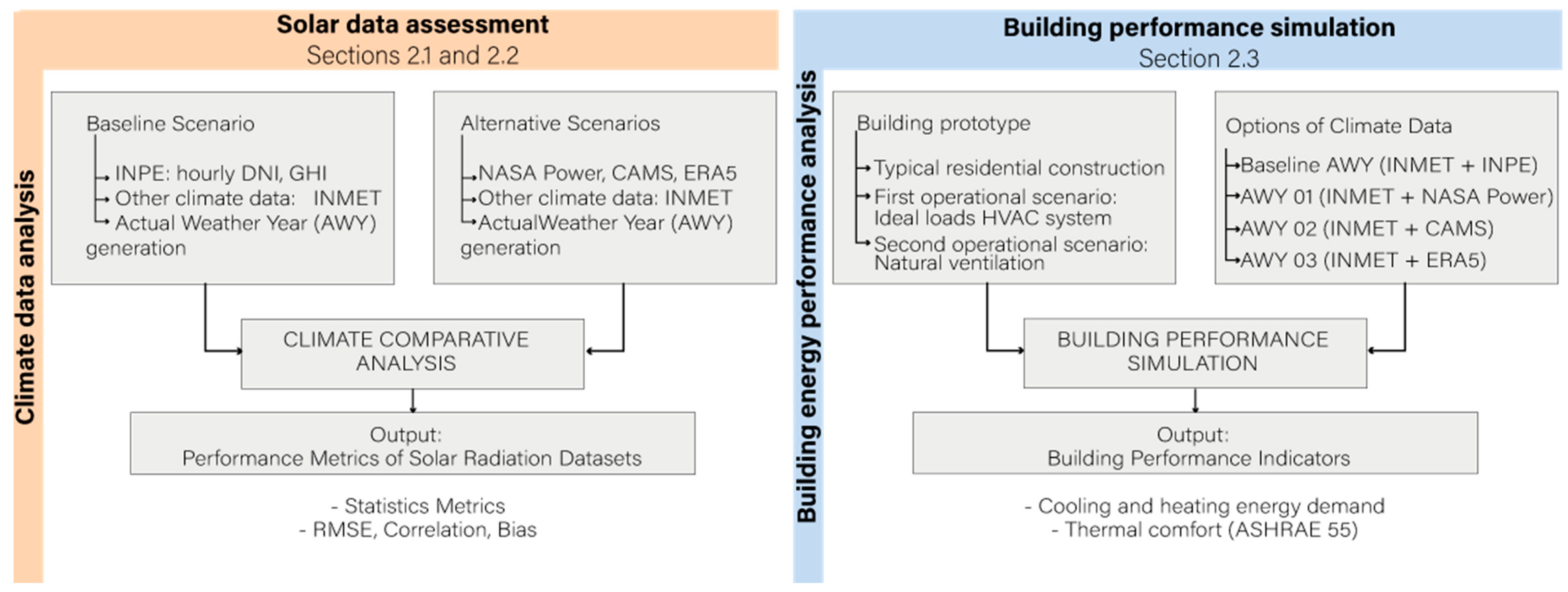

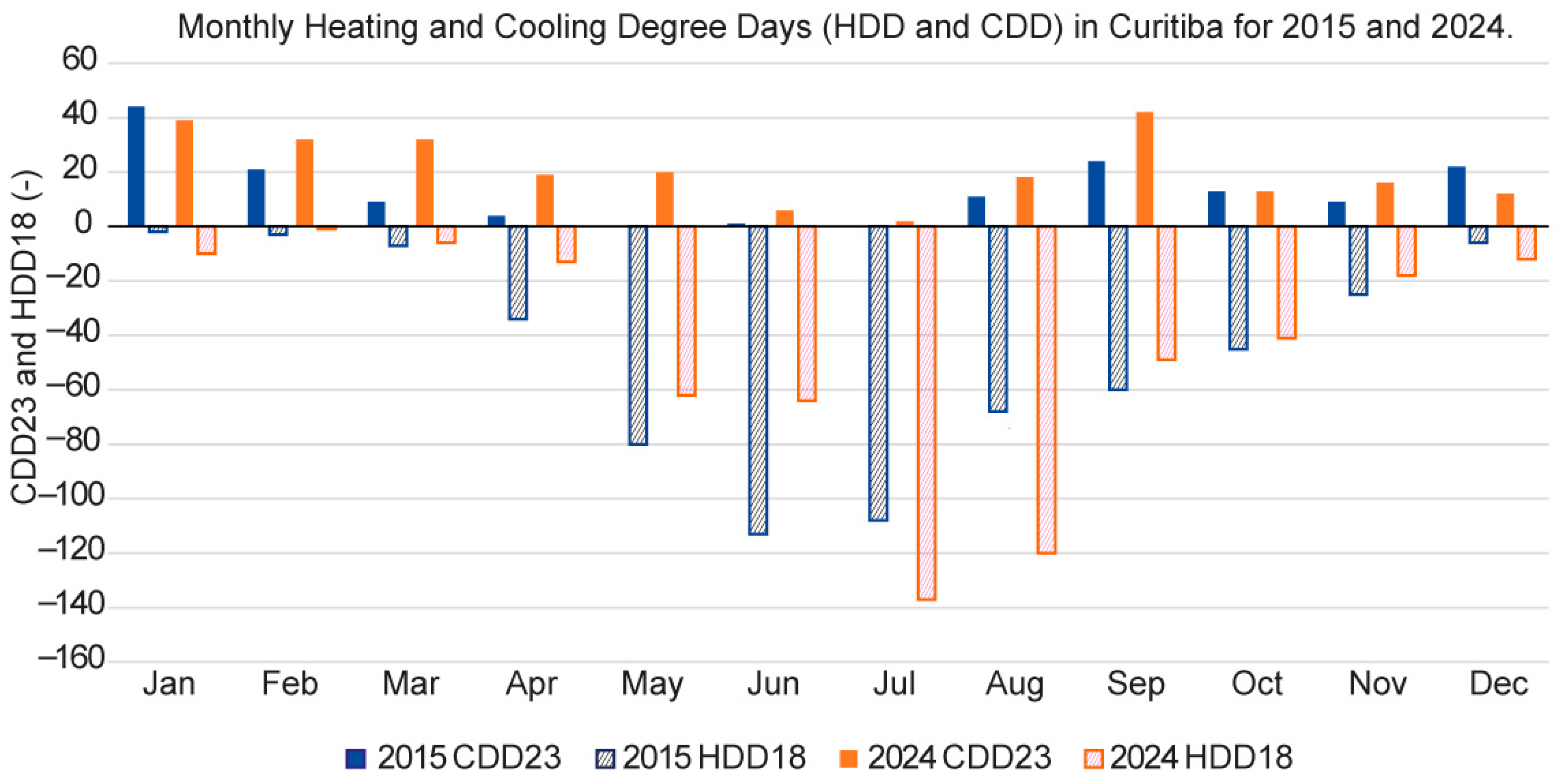
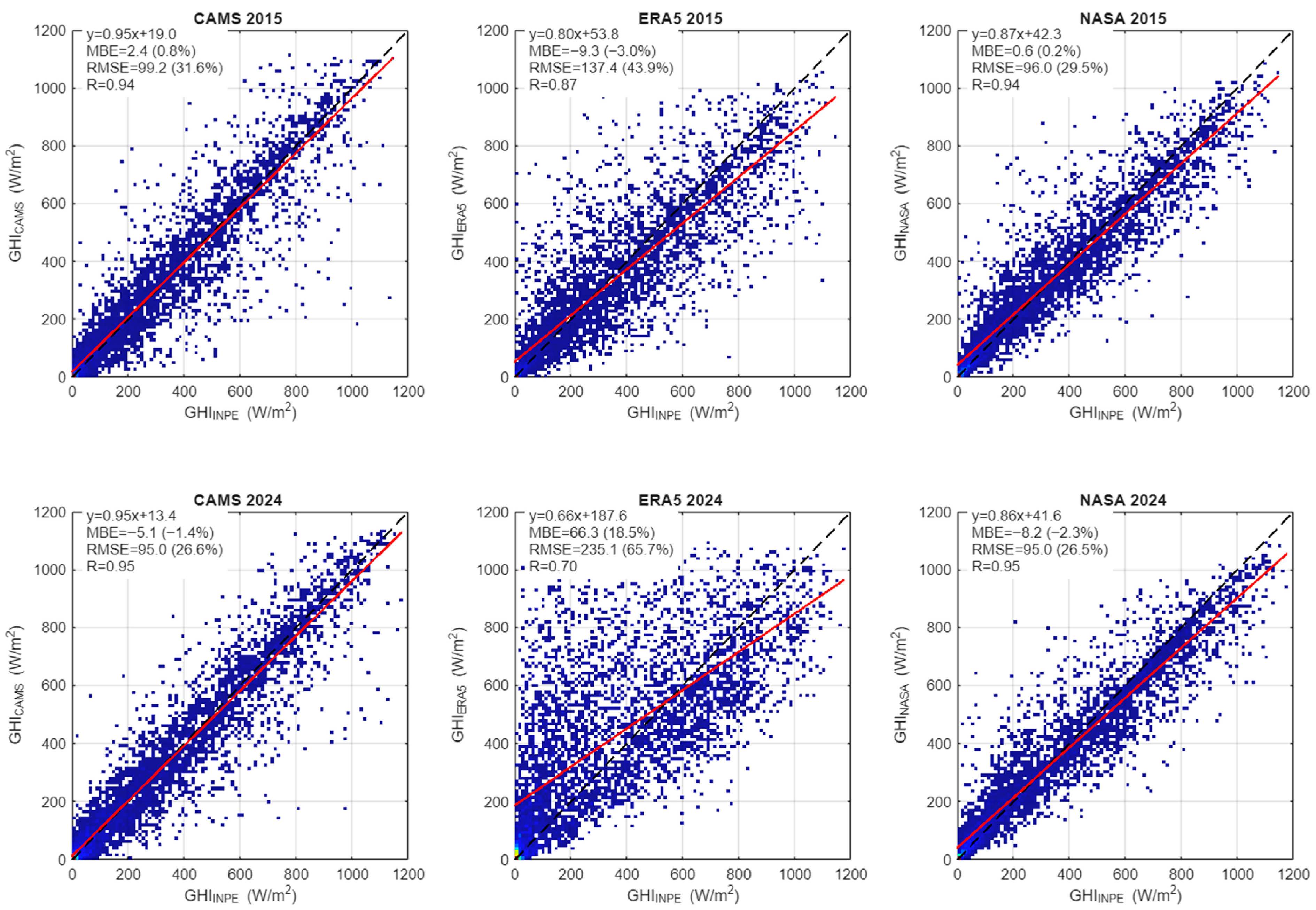
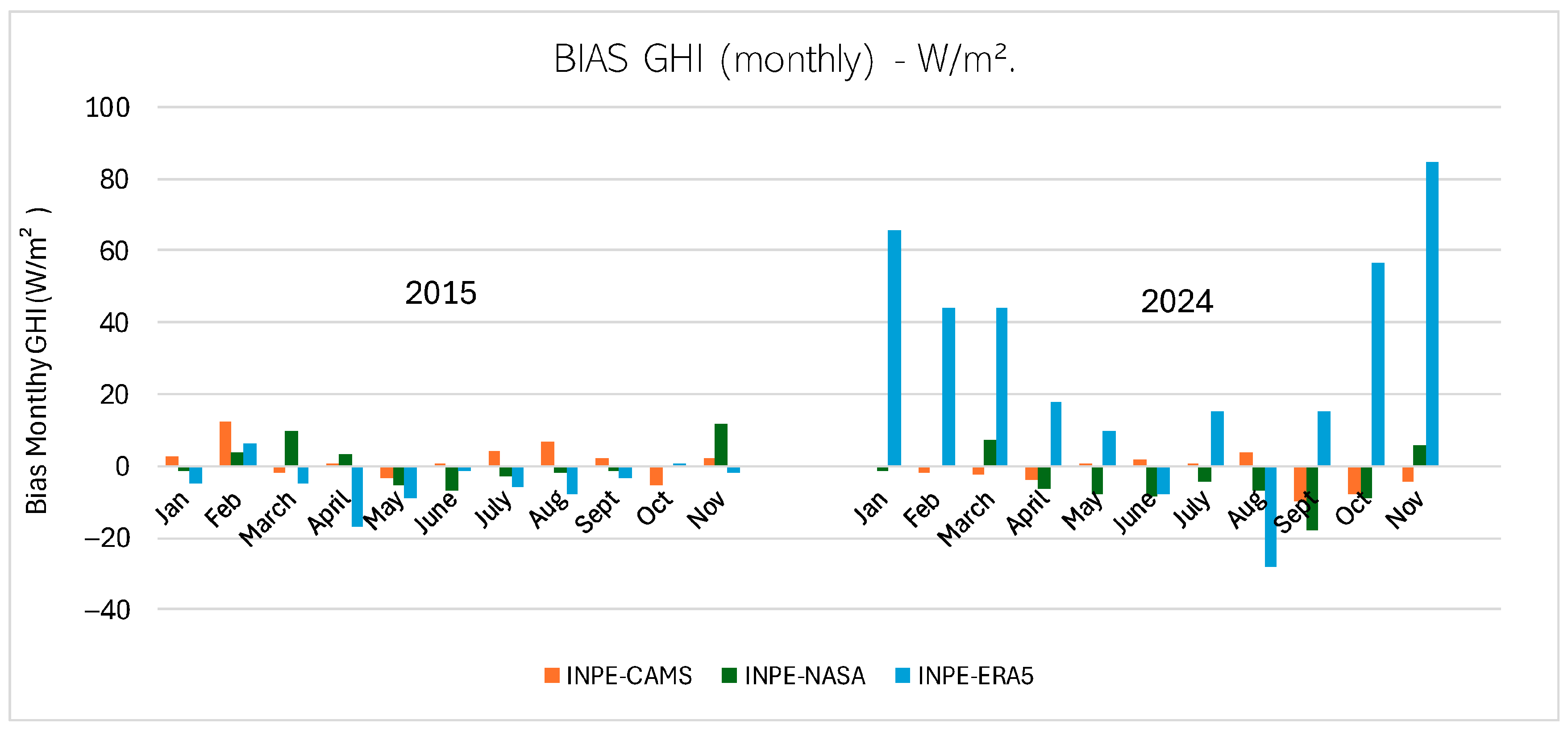


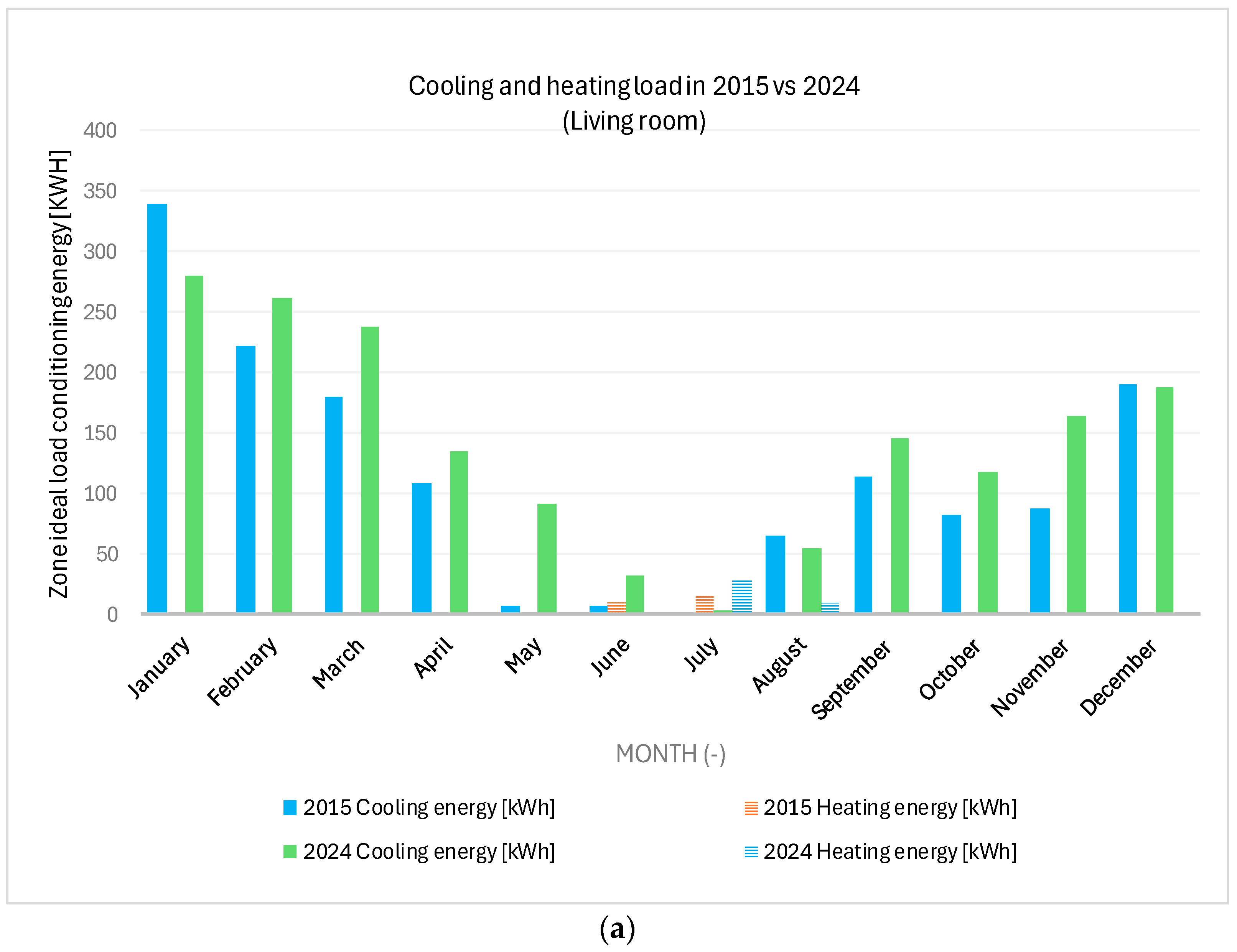
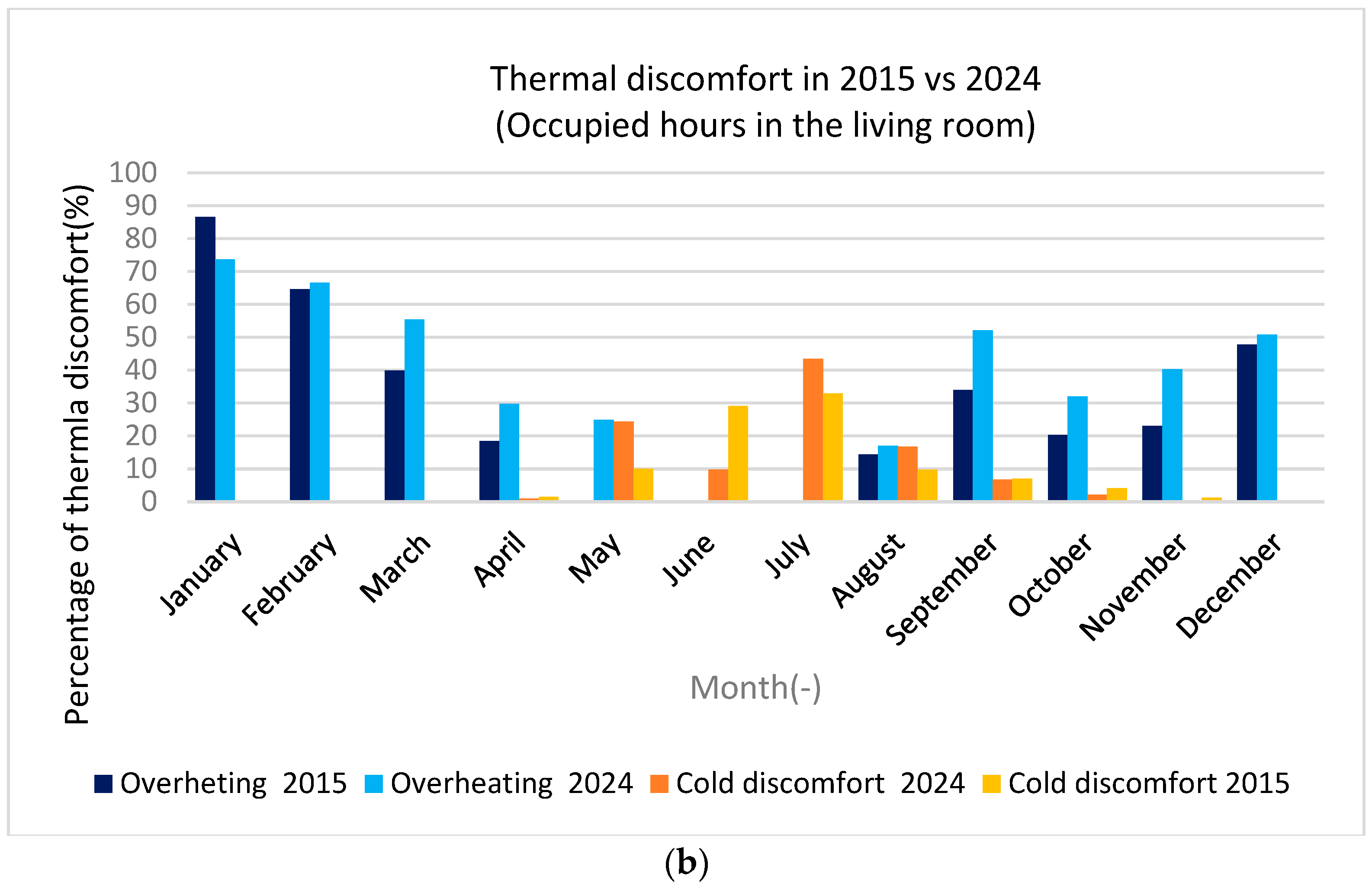

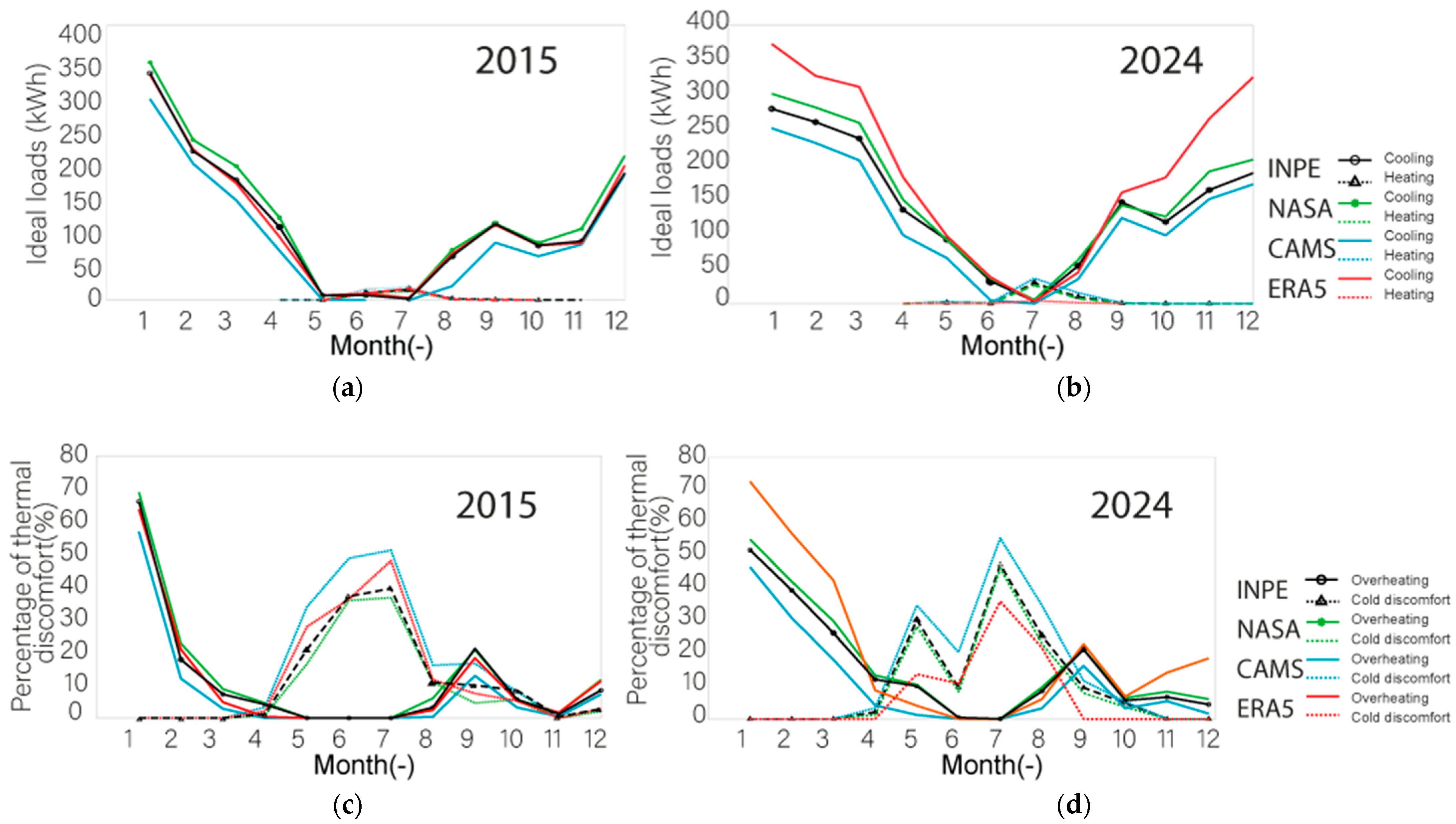
| Months | ||||||||||||
|---|---|---|---|---|---|---|---|---|---|---|---|---|
| GHI (Wh/m2) | 1 | 2 | 3 | 4 | 5 | 6 | 7 | 8 | 9 | 10 | 11 | 12 |
| Mean 2015 | 399.9 | 358.3 | 319.6 | 314.1 | 244.7 | 254.9 | 239.9 | 352.6 | 331.4 | 270.4 | 253.9 | 326.9 |
| Mean 2024 | 420.3 | 410.1 | 361.1 | 331.6 | 308.1 | 324.4 | 271.1 | 399.9 | 374.8 | 365.9 | 351.2 | 344.4 |
| Peak 2015 | 1144.9 | 1048.6 | 1100.7 | 973.5 | 794.5 | 699.0 | 753.7 | 914.6 | 993.2 | 1005.7 | 976.7 | 1089.0 |
| Peak 2024 | 1175.2 | 1129.2 | 1061.2 | 975.4 | 789.3 | 717.5 | 744.8 | 897.9 | 1009.6 | 1045.1 | 1118.6 | 1132.4 |
| Std 2015 | 342.5 | 312.8 | 276.9 | 263.0 | 212.1 | 218.4 | 218.1 | 272.5 | 300.2 | 267.8 | 245.4 | 287.7 |
| Std 2024 | 336.0 | 337.6 | 301.0 | 277.6 | 258.3 | 226.6 | 241.5 | 281.4 | 305.0 | 321.4 | 303.7 | 299.0 |
| Dataset | Data Availability | Format | Units | Type |
|---|---|---|---|---|
| NASA POWER | 1983–present | .CSV, JSON, ASCII, NetCDF | W/m2 | Satellite-based |
| CAMS | 2004 to present | .CSV, NetCDF | W/m2 | Satellite-based |
| ERA5 | 1959–present | NetCDF, GRIB | J/m2/h → W/m2 | Reanalysis |
| Geometry | Input Parameters | Base Case Properties | ||
|---|---|---|---|---|
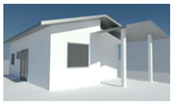 |  | U value (Wm−2 K 1) | External walls | 2.43 |
| Roof | 1.75 | |||
| Windows | 5.7 | |||
| Solar absorptance (–) | External walls Roof | 0.55 0.6 | ||
| SHGC (–) | Windows | 0.8 | ||
| Internal Gains Parameters | Daily Occupancy Schedules | ||
|---|---|---|---|
| Cooling setpoint temperature | 25 °C | Percentage of occupancy or usage (%) |  Time of day (-) |
| Heating setpoint temperature | 20 °C | ||
| Gross floor area | 54 m2 | ||
| Number of users | 5 | ||
| Light power density | 5 W/m2 | ||
| Comfort criteria | Adaptive comfort model, 80% acceptability | ||
| Building Operational Mode | Main Outputs | Output Units | Analysis Frequency | Weather Files (AWYs) |
|---|---|---|---|---|
| Ideal HVAC | Heating and cooling energy demand | kWh/m2 | Annual (whole building); monthly (individual rooms) | AWYs based on:
|
| Natural Ventilation | Thermal comfort (overheating and cold discomfort) | % of occupied hours | Annual (mean per occupied zones for occupied hours) and monthly (per room for occupied hours) |
| Dataset | Year | GHI | DNI | ||
|---|---|---|---|---|---|
| Correlation | Bias | Correlation | Bias | ||
| NASA | 2015 | Very High | Low | High | High |
| 2024 | |||||
| CAMS | 2015 | Very High | Low | High | High |
| 2024 | |||||
| ERA5 | 2015 | High | Moderate | Medium | High |
| 2024 | Medium | High | Very Low | Low | |
| Scenario | Cooling (kWh/m2) | Heating (kWh/m2) | Overheating (%) | Cold Discomfort (%) |
|---|---|---|---|---|
| 2015 | 46.8 | 1.85 | 18 | 9.5 |
| 2024 | 58.6 | 2.26 | 23 | 9.7 |
Disclaimer/Publisher’s Note: The statements, opinions and data contained in all publications are solely those of the individual author(s) and contributor(s) and not of MDPI and/or the editor(s). MDPI and/or the editor(s) disclaim responsibility for any injury to people or property resulting from any ideas, methods, instructions or products referred to in the content. |
© 2025 by the authors. Licensee MDPI, Basel, Switzerland. This article is an open access article distributed under the terms and conditions of the Creative Commons Attribution (CC BY) license (https://creativecommons.org/licenses/by/4.0/).
Share and Cite
Walsh García, A.S.; Rocha, A.P.d.A.; Vilela, O.d.C.; Mendes, N. Assessment of Solar Radiation Datasets for Building Energy Simulation. Buildings 2025, 15, 3337. https://doi.org/10.3390/buildings15183337
Walsh García AS, Rocha APdA, Vilela OdC, Mendes N. Assessment of Solar Radiation Datasets for Building Energy Simulation. Buildings. 2025; 15(18):3337. https://doi.org/10.3390/buildings15183337
Chicago/Turabian StyleWalsh García, Angélica S., Ana Paula de Almeida Rocha, Olga de Castro Vilela, and Nathan Mendes. 2025. "Assessment of Solar Radiation Datasets for Building Energy Simulation" Buildings 15, no. 18: 3337. https://doi.org/10.3390/buildings15183337
APA StyleWalsh García, A. S., Rocha, A. P. d. A., Vilela, O. d. C., & Mendes, N. (2025). Assessment of Solar Radiation Datasets for Building Energy Simulation. Buildings, 15(18), 3337. https://doi.org/10.3390/buildings15183337







